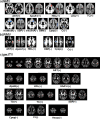Association of carotid atherosclerosis with brain tissue integrity and metabolic parameters in type 2 diabetes patients
- PMID: 40822944
- PMCID: PMC12353737
- DOI: 10.3389/fendo.2025.1586085
Association of carotid atherosclerosis with brain tissue integrity and metabolic parameters in type 2 diabetes patients
Abstract
Background: Type 2 diabetes mellitus (T2DM) is known to adversely impact brain health, leading to cognitive decline and brain tissue volume reduction. This study aimed to assess the damage to gray-white matter junction tissue volume (gwJTV) in T2DM patients with and without carotid artery plaques, and its association with various metabolic parameters.
Methods: We conducted a cross-sectional study involving 69 T2DM patients, employing three-dimensional T1-weighted MRI scans to measure brain tissue volumes, particularly gwJTV, and analyzing blood samples for metabolic parameters. Voxel-based (VBA) and region-of-interest (ROI) analyses of gwJTV were performed to evaluate the group difference with and without carotid artery plaques and to determine correlations to metabolic biomarkers.
Results: Voxel-based and region-of-interest analyses revealed that participants with carotid plaques had lower gwJTV than those without at the specific brain area. ROI results study further demonstrated positive associations between gwJTV and metabolic parameters such as AST, ApoB, and LDL, and negative associations with C-peptide, creatinine, and hsCRP.
Conclusion: Our findings suggest that gwJTV could be a valuable imaging biomarker for monitoring brain and vascular health in T2DM patients, particularly those affected by carotid atherosclerosis.
Keywords: brain; carotid artery plaque; gray-white matter junction volume; metabolic parameters; type 2 diabetes.
Copyright © 2025 Lim, Ryu, Tian, Jun, Park, Jeong and Jahng.
Conflict of interest statement
The authors declare that the research was conducted in the absence of any commercial or financial relationships that could be construed as a potential conflict of interest.
Figures


Similar articles
-
Associations of Central Arterial Stiffness With Brain White Matter Integrity and Gray Matter Volume in MRI Across the Adult Lifespan.J Magn Reson Imaging. 2025 Jul;62(1):215-229. doi: 10.1002/jmri.29713. Epub 2025 Jan 10. J Magn Reson Imaging. 2025. PMID: 39792583 Free PMC article.
-
An analysis of brain structural changes in type 2 diabetes using advanced MRI techniques.Magn Reson Imaging. 2025 Sep;121:110419. doi: 10.1016/j.mri.2025.110419. Epub 2025 May 8. Magn Reson Imaging. 2025. PMID: 40348298
-
Gray Matter Reserve Modulates the Association between Glymphatic System Function and Cognition in Patients with Type 2 Diabetes Mellitus.Neuroendocrinology. 2025;115(1):48-59. doi: 10.1159/000542902. Epub 2024 Dec 2. Neuroendocrinology. 2025. PMID: 39622216
-
Magnetic resonance perfusion for differentiating low-grade from high-grade gliomas at first presentation.Cochrane Database Syst Rev. 2018 Jan 22;1(1):CD011551. doi: 10.1002/14651858.CD011551.pub2. Cochrane Database Syst Rev. 2018. PMID: 29357120 Free PMC article.
-
[Volume and health outcomes: evidence from systematic reviews and from evaluation of Italian hospital data].Epidemiol Prev. 2013 Mar-Jun;37(2-3 Suppl 2):1-100. Epidemiol Prev. 2013. PMID: 23851286 Italian.
References
-
- Espeland MA, Bryan RN, Goveas JS, Robinson JG, Siddiqui MS, Liu SM, et al. Influence of type 2 diabetes on brain volumes and changes in brain volumes results from the women’s health initiative magnetic resonance imaging studies. Diabetes Care. (2013) 36:90–7. doi: 10.2337/dc12-0555, PMID: - DOI - PMC - PubMed
MeSH terms
Substances
LinkOut - more resources
Full Text Sources
Medical
Miscellaneous

